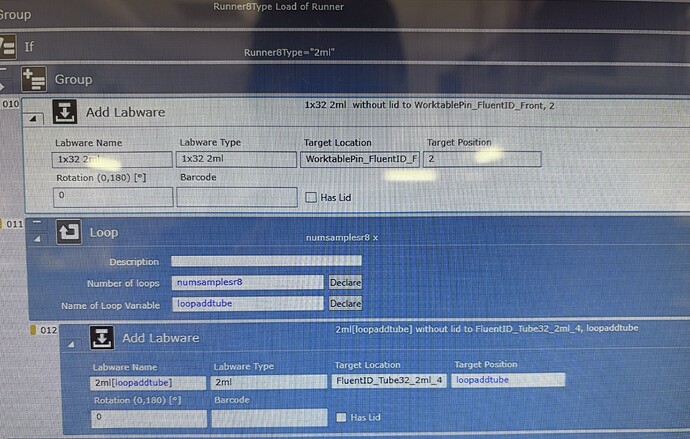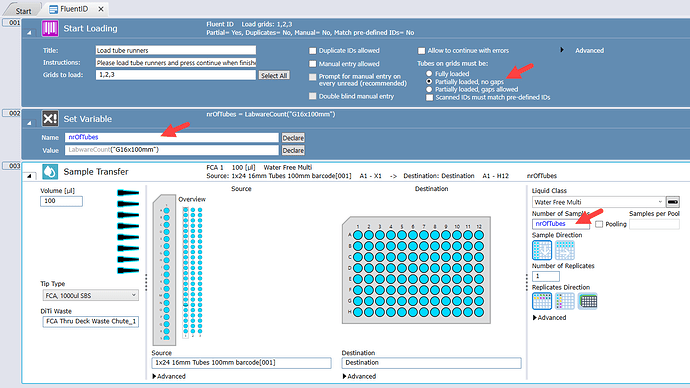So I have been able to create a script to load different tube runners in a run, however I’ve now run into the issue where I want the instrument to generate the number of samples on the tube rack after the user has had the ability to insert the number of samples being tested. I have a loop and an add labware but I haven’t had any luck. I preface that in my work table it will show the tubes generated based on the number of samples entered but when I go to start loading in touch tools the rack will be full but in my work table it’ll be the exact number entered. Does anyone have any suggestions?
Can you share your add Labware loop?
Hi yes definitely. Here is the way I have it programmed and it works! However when I type in my number of samples (let’s say 5) it will load the number of tubes (5) on the software but when I go to load the tube rack with FluentID it will say my rack is full even though in the software work table it shows I only have 5 tubes on the rack.
are you expecting the FluentID “Start Loading” command to react to the number of tubes configured on the worktable ??
I don’t believe the FluentID works like that - there is a “LabwareCount” variable used to extract the number of tubes scanned by the Fluent ID
One could add a tube runner already full of tubes to the SW worktable (also with Add Labware when needed for each runner prefilled with tubes), scan the runner filled with a smaller / variable number of tubes added consecutively from the back to the runner, use function LabwareCount() to find out how many tubes were actually scanned = present, and then pipette only for the first ‘nrOfTubes’ samples for example use the number of samples parameter of a Sample Transfer.
Or what would be the advantage for you of using Add Labware for each single tube, besides the graphic on the worktable window?
Hi there apologies for the response time. So I did get it to work. The fluent ID is able to scan the number of samples variable that I entered when given the user prompt and they also generate on the tube runner as well like they should. However I come to realize that the only runner that is having a bit of difficulty is the 1x32 2ml SL runner and Im beginning to think that maybe it could be due the fact that it has a small ledge that the snap cap of the tube can rest on and it could be confusing those with actual tubes? Silly theory but I don’t know why it’s having such difficulty. Thank you so much for your assistance and advice on this
Hi Snowball this is a great idea! I guess I had used the Add Labware command so it could add the tubes using the variable and didn’t know another way of how to make that happen. As far as pipetting goes would you recommend using a work list for this as I have the runners generated or what would you best recommend? I liked your idea it seems simple and easy I’m just not sure where to start. Appreciate your creativeness!
When the samples in the tube runners are filled from the first position of the first runner consecutively i.e. partially loaded, no gaps and then followed by a liquid transfer that goes 1:1 in the same sample order to a microplate, one can pipette it with the Sample Transfer command. It also allows to leave a well offset for some empty wells at the beginning of the plate (for controls, standard curve etc… , open at the Advanced section below the Destination plate ). And for the variable number of tubes (= samples) there is a parameter at the right side of Sample Transfer. Hence the script will look somehow like this for pipetting a variable number of tubes/samples 1:1 into a Destination plate
Worklist would be a better choice if the pipetting pattern is more complex so it cannot be done by a Sample Transfer. For example if you want to pipette the samples in the order of a barcode list and the samples are in random positions within tube runners. Though be aware if tips have to drive individually to separate tubes to do some sort of hit-picking, this takes much longer runtime, distances for the FCA channel movements are also longer with tubes in tube runners compared to hitpicking in a microplate.

